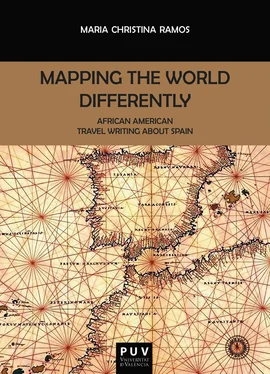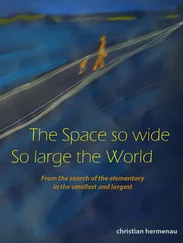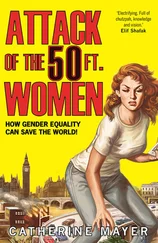Chapter 3 focuses on the travels of the main character in Frank Yerby’s 1965 novel An Odor of Sanctity : A Novel of Medieval Moorish Spain . Read through the lens of travel writing, this novel exposes the ways in which the experience of travel and cultural exchange can unsettle one’s sense of home and self. The novel, set against the backdrop of medieval Iberia, blurs the boundaries between Europe, Africa, and the Middle East as it maps a trans-Mediterranean geography and culture in which a network of sites of cultural and material exchange tie disparate groups together in an intimate narrative over an expanse of time. The novel critiques nationalism, among other essentialist identities, as the protagonist restlessly roams this territory in search of the component ingredients through which to craft and express a sense of an authentic self, futilely attempting to stabilize boundaries and categories that stubbornly refuse to remain static. Even the form of Yerby’s novel resists clear categorization by genre, developing and abandoning the conventions of a number of possible genres—the popular romance, the actionadventure tale, historical fiction—leaving the hybrid format of the travel narrative as a useful way to conceive of the plot.
Chapter 4 explores the self-conscious use of the travel narrative as a tool for developing political wisdom in Richard Wright’s Pagan Spain (1957), his book-length travelogue of his trips to Spain. When read through the lens of his other travel narratives of the 1950s, particularly his 1956 The Color Curtain: A Report on the Bandung Conference, Pagan Spain is revealed as a complex investigation of the modern heritage of religious, racial, and national identities as they were manifesting themselves during the height of the Cold War. Wright uses his travel narrative of Spain, a Western European nation, to challenge the three-world concept of the map that was then dominating Cold War politics (and continues to haunt conceptions of the globe) in the hopes of envisioning a new system of global relations that could escape the Cold War’s binaries and limited political options. He uses his rendering of the Spanish nation as a meditation on Western identity, ultimately mapping Spain at the heart of the modern European colonial identity and presenting its fate under Franco as a cautionary tale for Cold War powers. Wright further argues for the need to understand our methods of relating to others as central to any construction of identity that is meaningful.
Finally, Chapter 5 turns to a contemporary African American travel narrative about Spain. It compares Lori Tharps’s Kinky Gazpacho (2008) to earlier travel writing discussed in this study to help shed light on the way changing relationships to nation and race in the U.S. have affected representations of Spain and the imaginative geography in which it is envisioned. Tharps’s narrative begins with different assumptions about the intersection of race and nation that affect her relation to and representation of Spain. The effects of travel, however, are such that towards the end of her book, reflection on these categories begins to lead her into territory similar to that developed by the authors discussed in the previous chapters.
These chapters build on one another to show various relationships with Spain as a space that demands new ways of understanding individual identity in relation to a global imaginary that is meaningful in the present.
_________________________
1 At the 1937 Second American Writer’s Congress in New York, Wright made his pro-Loyalist position clear. In addition, he published a series of articles for the Daily Worker about the Spanish Civil War and contributed a letter to the 1938 volume Writers Taking Sides: Letters about the War in Spain from 419 American Authors .
2 Fabre notes Wright’s increasing dissatisfaction with even the freedom of life in exile ( Unfinished 383).
3 In an interview given three years later, Wright explains that, in the U.S., black writers are encouraged to write about “universal” topics, minimizing their experience as black Americans. Wright counters that the “ghetto” experience itself is universal (Hakutani 122). In Pagan Spain , Wright refers to oppressed groups within Spain, including Protestants, Jews, and women, as “white Negroes,” revealing his use of the category of “Negro” as an experience of the oppression rather than a racial designation.
4 This study will not examine the historical accuracy of the representations of Spain in this travel writing; that is, it will not attempt to judge the veracity of these representations of Spain as “objective” accounts of the places and history represented (though this could be an interesting project, yielding interesting results regarding problems of translation as there are many problematic renderings of Spanish culture throughout).
5 Here I am drawing from Edward Said’s notion of imaginative geography as the process through which cultural meanings and values are assigned to particular material spaces and the ways in which these meanings reflect the relations between the creators of such spaces and their subjects (54-5).
Конец ознакомительного фрагмента.
Текст предоставлен ООО «ЛитРес».
Прочитайте эту книгу целиком, купив полную легальную версию на ЛитРес.
Безопасно оплатить книгу можно банковской картой Visa, MasterCard, Maestro, со счета мобильного телефона, с платежного терминала, в салоне МТС или Связной, через PayPal, WebMoney, Яндекс.Деньги, QIWI Кошелек, бонусными картами или другим удобным Вам способом.












